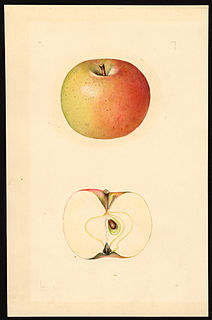| Malus pumila 'Malinda' | |
|---|---|
 | |
| Species | Malus pumila |
| Hybrid parentage | Apparently unknown [1] |
| Origin | Vermont [2] |
The malinda apple is a cultivar of domesticated apple, originating in New England., [3] most likely Vermont. [2]
| Malus pumila 'Malinda' | |
|---|---|
 | |
| Species | Malus pumila |
| Hybrid parentage | Apparently unknown [1] |
| Origin | Vermont [2] |
The malinda apple is a cultivar of domesticated apple, originating in New England., [3] most likely Vermont. [2]
Malinda genes, whether as a parent, grandparent, or great-grandparent, led to all of

Minnesota is a state in the Upper Midwest region of the United States. It is known as the "Land of 10,000 Lakes". Its official motto is L'Étoile du Nord, French for "The Star of the North".
A state fair is an annual competitive and recreational gathering of a U.S. state's population, usually held in late summer or early fall. It is a larger version of a county fair, often including only exhibits or competitors that have won in their categories at the more-local county fairs.

La Crescent is a city in Houston and Winona counties in the U.S. state of Minnesota. The population was 4,830 at the 2010 census.

Malus is a genus of about 30–55 species of small deciduous trees or shrubs in the family Rosaceae, including the domesticated orchard apple – also known as the eating apple, cooking apple, or culinary apple. The other species are commonly known as crabapples, crab apples, crabtrees, or wild apples.

The Haralson is a cultivar of apple that is medium-sized and has a round-conic shape.

Rosa gallica, the Gallic rose, French rose, or rose of Provins, is a species of flowering plant in the rose family, native to southern and central Europe eastwards to Turkey and the Caucasus. It was one of the first species of rose to be cultivated in central Europe.

Honeycrisp is an apple cultivar developed at the Minnesota Agricultural Experiment Station's Horticultural Research Center at the University of Minnesota, Twin Cities. Designated in 1974 with the MN 1711 test designation, patented in 1988, and released in 1991, the Honeycrisp, once slated to be discarded, has rapidly become a prized commercial commodity, as its sweetness, firmness, and tartness make it an ideal apple for eating raw. "...The apple wasn't bred to grow, store or ship well. It was bred for taste: crisp, with balanced sweetness and acidity." It has larger cells than most apple cultivars, a trait which is correlated with juiciness, as theoretically a higher number of cells rupture when bitten releases more juice in the mouth. The Honeycrisp also retains its pigment well and has a relatively long shelf life when stored in cool, dry conditions. Pepin Heights Orchards delivered the first Honeycrisp apples to grocery stores in 1997. The name Honeycrisp was trademarked by the University of Minnesota, but university officials were unsure of its protection status in 2007. It is now the official state fruit of Minnesota.

The 'Sturmer Pippin' is a dessert apple cultivar, believed to be a 'Ribston Pippin' and 'Nonpareil' cross.

An apple is an edible fruit produced by an apple tree. Apple trees are cultivated worldwide and are the most widely grown species in the genus Malus. The tree originated in Central Asia, where its wild ancestor, Malus sieversii, is still found today. Apples have been grown for thousands of years in Asia and Europe and were brought to North America by European colonists. Apples have religious and mythological significance in many cultures, including Norse, Greek, and European Christian tradition.

The Zestar! apple or Minnewashta (cultivar) is an apple cultivar released in 1999. It was developed by the horticulturalists at the Minnesota Landscape Arboretum's Horticultural Resource Center, at the University of Minnesota.

Beacon is a cold-hardy cultivar of apple developed by University of Minnesota in 1936. It is a cross between 'Wealthy' and 'Malinda' apples. This apple is medium in size with full, deep red stripes. Its flesh is pulpy and fairly soft, with a mildy sweet flavor. This apple is good for cooking and eating.

The 'York Imperial', or 'York', is a cultivar of apple from which a number of other valuable strains and cultivars have arisen, including four sport varieties: Commander York, Ramey York, Red Yorking, and Yorking.

SweeTango is the brand designation of the cultivated apple 'Minneiska'. It is a patented cross breed between the 'Honeycrisp' and the Zestar! apple. The trademark name belongs to the University of Minnesota. The apple is a controlled and regulated product for marketing to the public. The apple is controlled and regulated for marketing, allowing only exclusive territories for growing. It has a sweet-tart taste that some food writers have described as something between brown sugar and spiced apple cider.

The Wealthy is an American apple cultivar, and was the earliest to thrive in the Minnesota climate. Horticulturalist Peter Gideon first grew it in 1868, after years of trial and error with various apple varieties.

Lord Lambourne is an apple cultivar with a sweet sharp flavor. It was raised by Laxtons Brothers Ltd in 1907 in Bedford, England. It is a holder of the Royal Horticultural Society Award of Garden Merit
The Minnesota State Horticultural Society (MSHS), with headquarters in Roseville, Minnesota, is a nonprofit membership organization that provides education and resources to northern gardeners in the United States. It publishes Northern Gardener, a bi-monthly magazine that is the only U.S. publication devoted exclusively to gardening in Hardiness Zones 3-5. Its "Garden-in-a-Box" program provides raised bed garden boxes, along with soil and vegetable plants, to low-income families and schoolchildren in the greater Minneapolis and St. Paul, Minnesota area and elsewhere in Minnesota. "Minnesota Green" is a MSHS program that coordinates donations of plant material from growers, garden centers, and individuals to public space and community gardens. MSHS offers classes year-round on gardening subjects. MSHS currently has 10,000 members and subscribers to its publication.

'Worcester Pearmain' is an early season English cultivar of domesticated apple, that was developed in Worcester, England, by a Mr. Hale of Swanpool in 1874. It was once the most popular cultivar in England for early autumn harvest and is still popular to keep in the garden. It has been extensively used in apple breeding.

Autumn Glory is an apple cultivar developed by Domex Superfresh Growers, which is based in Washington (state). The fruit is marketed as Autumn Glory. The fruit, which has cinnamon tasting notes, is grown by Domex Superfresh Growers with a production of about 56,000 trees as of November 2014. Autumn Glory apples have a very sweet, firm flesh with hints of cinnamon and subtle notes of caramel. After being in development for a decade, the apple was released in the 2011 season. The Autumn Glory variety is a hybrid of the Fuji (apple) and Golden Delicious apple with a red coloring on a yellow background. The original pollination cross breed was made by Dr. Yu Lin Wang in 1976. It is picked in mid- to late-October of each year.
John Samuel Harris was an early American horticulturist, the first person to successfully plant and propagate apple trees in Minnesota, a climate in which it was previously thought that the fruit could not survive the harsh northern U.S winters.